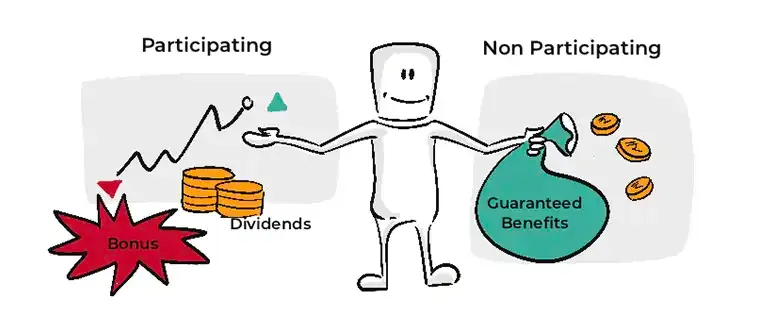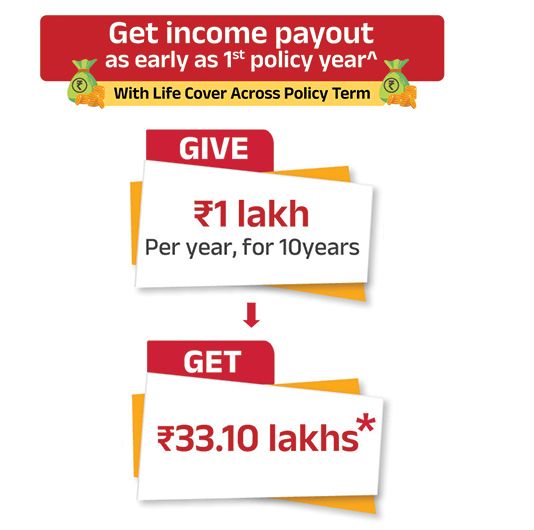Though a whopping 17.7 percent of the world's population resides in India, 75% of Indians above the age of 18 have little or no awareness about financial concepts. Only 3 out of 100 people in India have a Life Insurance Policy. This is a sad number because despite the advancements happening, the majority of the country is still uninsured and financially vulnerable - in case an emergency strikes.
Understanding the importance of life insurance and its nuances is crucial to recognise how it could help secure your family’s future. But remember, not all policies are the same. Life insurance plans come in all shapes and sizes, and to choose one that fits you perfectly is to understand the finer differences between them.
One such factor of difference is whether or not a policy pays you bonuses, i.e., passes on a portion of your insurance company’s profits to you. On this basis, two types of plans come to the picture: Participating and Non-Participating life insurance plans.
Sounds confusing? Let’s simplify it for you!
What is a Participating Life Insurance Policy?
Also referred to as a par policy, it allows you to participate in the profits of your life insurance company. Just like any other organisation, a life insurance company, too, earns profits throughout a financial year. In a participating plan, these profits are shared with you.
How does an insurance company earn profits? By selling more policies in a year, receiving lesser claims, getting returns from investing the premiums collected into approved investment tools - like government bonds, stock market, equity instruments, debt instruments - depending on product to product.
The benefits are paid out to you in the form of bonuses or dividends, typically on an annual basis. They are in addition to the regular maturity and death benefits paid by the life insurance plan.
If you hold a participating policy, you can make use of the bonuses and/or dividends in different ways -
- You can receive the payouts as and when they are made by the insurance company.
- You can use these payouts to pay the premium due on your policy.
- You can also deposit the bonuses/dividends to the insurance company, and generate interests on the funds.
Please note: The bonuses are variable in nature, and that past history of bonuses may not be indicative of any future benefits.
What is a Non-Participating Life Insurance Policy?
Also known as a non-par plan, it does not offer any dividend or bonus payouts. As the name suggests, you, the policyholder, do not participate in the profits of your life insurance provider.
There is no variable benefit like dividends or bonuses in this plan. What is promised when you buy the plan is exactly what you get, i.e., guaranteed benefits on death and maturity. It also offers guaranteed bonuses that accrue during the policy period, provided you have paid all your premiums.
Since these plans are plain and simple, they are relatively cheaper and less risky than Participating Life Insurance Plans.
What are Guaranteed and Non-Guaranteed Benefits?
- Guaranteed Benefits: Sum assured at policy maturity and/or sum assured on death of the policyholder. Both Participating and Non-Participating policyholders can avail them.
- Non-Guaranteed Benefits: Bonuses or cash dividends offered by the insurance company only to Participating policyholders. The benefits depend on the performance of the insurance company.
Participating and Non-Participating Plans - a comparative study
|
|
Participating Life Insurance
|
Non-Participating Life Insurance
|
|
Profit sharing with policyholder
|
The profits earned by the Insurance company are shared with you, the policyholder, in the form of bonuses.
|
The profits earned by the Insurance company are not shared with you.
|
|
Benefits
|
Both guaranteed as well as Non-Guaranteed benefits (in the form of bonuses) are offered
|
Only guaranteed benefits on policy maturity, or on your demise are offered
|
|
Cost
|
More expensive when compared to Non-Participating plans.
|
Cheaper when compared to Participating plans.
|
|
Risk factor
|
It is comparatively riskier in nature. But it can give you higher returns - depending on the performance of the insurance company.
|
No risk here. You receive the benefits that are guaranteed at the time of purchase.
|
Let’s understand the differences better - with the help of an example.
Rakesh, 35-year-old, buys a Whole life insurance with a cover of Rs. 10 lakhs. A Whole Life Insurance policy is a type of life insurance policy that covers you for your whole life. The policy will pay the cover amount in the event of your death. Or it will give you the Maturity Benefit when you hit a particular age.
The premium payment tenure for Rakesh’s policy is 10 years. Once he completes the payment tenure, he will receive the benefits for the next 40 years, on an annual basis, which shall be 5% of the sum assured.
Situation #1 - If it’s a Participating Whole Life Insurance Plan
Rakesh buys a participating whole life insurance plan of Rs. 10 lakhs coverage. He chose this plan because he has sufficient income to pay off the higher premiums, and wanted to earn something beyond the plain guaranteed returns.
3% of the sum assured = 5% of 10,00,000/-
= 50,000/-
Under this policy, once Rakesh turns 45, he shall get Rs. 30,000 as guaranteed annual income, for the next 40 years.
As per the policy prerequisites,
- He shall receive the sum assured of Rs. 10 lakhs as maturity benefit once the plan ends when he turns 100 years, or as death benefit to his nominee if he passes away during the policy period.
- Along with the guaranteed amount, Rakesh will also receive accrued bonuses or dividends, depending on the overall profits made by the insurance company.
Situation #2 - If it’s a Non-Participating Whole Life insurance Plan
Rakesh buys a non-participating whole life insurance plan of Rs. 10 lakhs coverage. He chose this policy because the premium is relatively cheaper and meets his monthly budget.
When his premium payments get over by the time he turns 45, he shall start receiving the annual payout of Rs. 50,000 - for the next 40 years.
According to the policy,
- He shall receive the sum assured of Rs. 10 lakhs as maturity benefit once the plan ends when he turns 100 years, or as death benefit to his nominee if he passes away during the policy period.
- Besides the guaranteed amount, he shall not receive any accrued bonuses or dividends as this is a Non-Participating policy.
As we saw, both the policies have their own advantages and limitations. A Non-Participating Plan offers fixed returns, while a Participating Plan is ideal for people who don’t just want simple benefits, but an upside in the form of bonuses and dividends. Understand the policies well, and go for the one that suits your needs the best.





